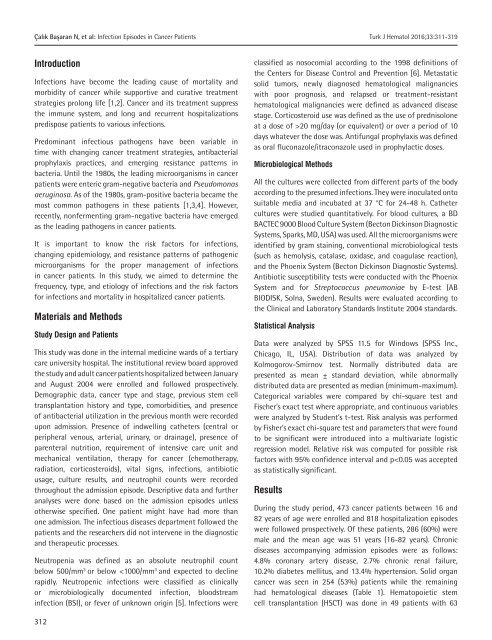Turkish Journal of Hematology Volume: 33 - Issue: 4
Create successful ePaper yourself
Turn your PDF publications into a flip-book with our unique Google optimized e-Paper software.
Çalık Başaran N, et al: Infection Episodes in Cancer Patients<br />
Turk J Hematol 2016;<strong>33</strong>:311-319<br />
Introduction<br />
Infections have become the leading cause <strong>of</strong> mortality and<br />
morbidity <strong>of</strong> cancer while supportive and curative treatment<br />
strategies prolong life [1,2]. Cancer and its treatment suppress<br />
the immune system, and long and recurrent hospitalizations<br />
predispose patients to various infections.<br />
Predominant infectious pathogens have been variable in<br />
time with changing cancer treatment strategies, antibacterial<br />
prophylaxis practices, and emerging resistance patterns in<br />
bacteria. Until the 1980s, the leading microorganisms in cancer<br />
patients were enteric gram-negative bacteria and Pseudomonas<br />
aeruginosa. As <strong>of</strong> the 1980s, gram-positive bacteria became the<br />
most common pathogens in these patients [1,3,4]. However,<br />
recently, nonfermenting gram-negative bacteria have emerged<br />
as the leading pathogens in cancer patients.<br />
It is important to know the risk factors for infections,<br />
changing epidemiology, and resistance patterns <strong>of</strong> pathogenic<br />
microorganisms for the proper management <strong>of</strong> infections<br />
in cancer patients. In this study, we aimed to determine the<br />
frequency, type, and etiology <strong>of</strong> infections and the risk factors<br />
for infections and mortality in hospitalized cancer patients.<br />
Materials and Methods<br />
Study Design and Patients<br />
This study was done in the internal medicine wards <strong>of</strong> a tertiary<br />
care university hospital. The institutional review board approved<br />
the study and adult cancer patients hospitalized between January<br />
and August 2004 were enrolled and followed prospectively.<br />
Demographic data, cancer type and stage, previous stem cell<br />
transplantation history and type, comorbidities, and presence<br />
<strong>of</strong> antibacterial utilization in the previous month were recorded<br />
upon admission. Presence <strong>of</strong> indwelling catheters (central or<br />
peripheral venous, arterial, urinary, or drainage), presence <strong>of</strong><br />
parenteral nutrition, requirement <strong>of</strong> intensive care unit and<br />
mechanical ventilation, therapy for cancer (chemotherapy,<br />
radiation, corticosteroids), vital signs, infections, antibiotic<br />
usage, culture results, and neutrophil counts were recorded<br />
throughout the admission episode. Descriptive data and further<br />
analyses were done based on the admission episodes unless<br />
otherwise specified. One patient might have had more than<br />
one admission. The infectious diseases department followed the<br />
patients and the researchers did not intervene in the diagnostic<br />
and therapeutic processes.<br />
Neutropenia was defined as an absolute neutrophil count<br />
below 500/mm 3 or below 20 mg/day (or equivalent) or over a period <strong>of</strong> 10<br />
days whatever the dose was. Antifungal prophylaxis was defined<br />
as oral fluconazole/itraconazole used in prophylactic doses.<br />
Microbiological Methods<br />
All the cultures were collected from different parts <strong>of</strong> the body<br />
according to the presumed infections. They were inoculated onto<br />
suitable media and incubated at 37 °C for 24-48 h. Catheter<br />
cultures were studied quantitatively. For blood cultures, a BD<br />
BACTEC 9000 Blood Culture System (Becton Dickinson Diagnostic<br />
Systems, Sparks, MD, USA) was used. All the microorganisms were<br />
identified by gram staining, conventional microbiological tests<br />
(such as hemolysis, catalase, oxidase, and coagulase reaction),<br />
and the Phoenix System (Becton Dickinson Diagnostic Systems).<br />
Antibiotic susceptibility tests were conducted with the Phoenix<br />
System and for Streptococcus pneumoniae by E-test (AB<br />
BIODISK, Solna, Sweden). Results were evaluated according to<br />
the Clinical and Laboratory Standards Institute 2004 standards.<br />
Statistical Analysis<br />
Data were analyzed by SPSS 11.5 for Windows (SPSS Inc.,<br />
Chicago, IL, USA). Distribution <strong>of</strong> data was analyzed by<br />
Kolmogorov-Smirnov test. Normally distributed data are<br />
presented as mean ± standard deviation, while abnormally<br />
distributed data are presented as median (minimum-maximum).<br />
Categorical variables were compared by chi-square test and<br />
Fischer’s exact test where appropriate, and continuous variables<br />
were analyzed by Student’s t-test. Risk analysis was performed<br />
by Fisher’s exact chi-square test and parameters that were found<br />
to be significant were introduced into a multivariate logistic<br />
regression model. Relative risk was computed for possible risk<br />
factors with 95% confidence interval and p

















